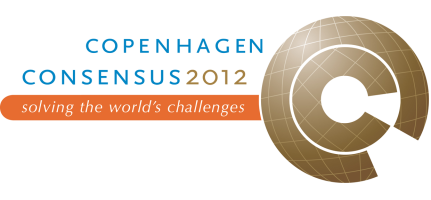Third Copenhagen Consensus: Trade Barriers, Anderson
Working Paper
A Working Paper on Trade Barriers has been written by Kym Anderson and released by the Copenhagen Consensus Center. The working paper used by the Expert Panel is available for download here, the finalized paper has been published in Global Problems, Smart Solutions - Costs and Benefits by Cambridge University Press.
Short summary
In the past three decades, there have been reductions in the numerous barriers to international trade in goods, in some services, and in capital flows. Even so, many remain. Such policies hurt the economies imposing them, but are particularly harmful to the world’s poorest people.
In his Working Paper for Copenhagen Consensus 2012, Kym Anderson argues that addressing this challenge would therefore also reduce poverty and thereby assist in meeting several of the other challenges identified in this project, including malnutrition, disease, poor education and air pollution.
The reluctance to reduce trade distortions is almost never because such policy reform involves government treasury outlays. Rather, trade distortions (and barriers to immigration) remain largely because further liberalization and subsidy cuts would redistribute jobs, income and wealth in ways that those in government fear would reduce their chances of remaining in power and, in countries where corruption is rife, possibly their own wealth.
The challenge involves finding politically attractive ways to phase out remaining distortions to world markets for goods and services. Kym Anderson focuses on how costly those anti-poor trade policies are, and examines possible strategies to reduce remaining distortions. He addresses four opportunities in particular.
Among the most-feasible opportunities available today for encouraging trade negotiations to stimulate significant market opening, the most obvious is a non-preferential legally binding partial liberalization of goods and services trade following the WTO’s current round of multilateral trade negotiations, the Doha Development Agenda.
The net present value of the future benefits of a Doha agreement ranges from $12 trillion to $64 trillion. The costs are less than $400 billion in present value terms, but they are mostly private rather than government costs and are dwarfed by the gross benefits. Today’s developing countries would reap just over half of those net gains, as their share of the global economy is assumed to grow throughout this century (although at a progressively slower rate after 2025). Their benefit/cost ratios from the trade reform opportunity offered by the Doha round are between 140 and 250, which means it is an extremely high payoff activity, if only the political will to bring about a successful conclusion to the Doha round can be found. The global benefit/cost ratios from Doha are not much lower, at between 90 and 180.
If for political reasons the Doha round cannot be brought to a successful conclusion with all the flexibilities demanded by developing countries, governments still have the opportunity to form preferential trade agreements.
One involves the proposed Trans-Pacific Partnership (TPP) among a subset of member countries of the Asia Pacific Economic Cooperation (APEC) grouping. The TPP began in 2006 when just four small APEC members (Brunei, Chile, New Zealand and Singapore) got together to begin negotiations for greater economic integration. Being already open liberal economies, their leaders saw this not as an end in itself but rather as a pathway for a more-expansive club. In September 2008 the United States announced its interest in joining the TPP, and by 2010 Australia, Malaysia, Peru and Vietnam also joined in to make the current total of nine of APEC’s 21 members.
Another sub-regional agreement involves extending the free-trade area among the 10-member Association of South East Asian Nations to include China, Japan and Korea (ASEAN+3).
The third opportunity is a free-trade area among all APEC countries. APEC leaders have endorsed both the Trans-Pacific Partnership and ASEAN+3 integration tracks and see them as potential pathways to a free trade agreement involving all APEC members.
Of the three possibilities among countries in the Asia-Pacific region, the greatest estimated gain would come if all APEC member countries agreed to form a region-wide free-trade area (FTAAP).
That is assumed to involve completely freeing all trade, albeit preferentially within the Asia-Pacific region (including Russia). This contrasts to a Doha agreement, which would only partially open up trade, albeit non-preferentially so that all trading partners are involved (as the WTO membership now includes nearly 160 members and thus almost all of world trade).
Since the APEC members are projected to comprise nearly three-fifths of global GDP by 2025, it is not surprising that a free trade agreement among them could yield a benefit to the world that is three-quarters of what Doha is projected to deliver. Furthermore, the FTAAP is projected to deliver a slightly greater benefit to developing countries as a group than is Doha. This is partly because under Doha developing countries are assumed to reform less than high-income countries, and partly because by 2025 the APEC grouping will account for around two-thirds of the GDP of all developing countries.
The two other opportunities analyzed by Kym Anderson involve sub-regional free trade agreements in the Asia-Pacific region, and so necessarily yield smaller benefits than a free trade agreement for the entire APEC region: fewer countries are liberalizing, and only for their trade with a subset of APEC members. Of those two, the ASEAN+3 proposal would yield more than twice the global and developing country benefits as the Trans-Pacific Partnership between the US and a number of small APEC economies.
Because under freer trade the world’s resources would be allocated more efficiently, cuts in trade barriers and subsidies would provide a means for citizens to spend more on other pressing problems, thereby indirectly contributing to opportunities to alleviate other challenges facing the world. They could alsodirectly alleviate poverty and thereby reduce environmental degradation and address other challenges such as communicable diseases, conflicts and arms proliferation, education under-investment, and hunger and malnutrition. According to Kym Anderson, all that is needed is the political will to agree to and implement such reforms.

